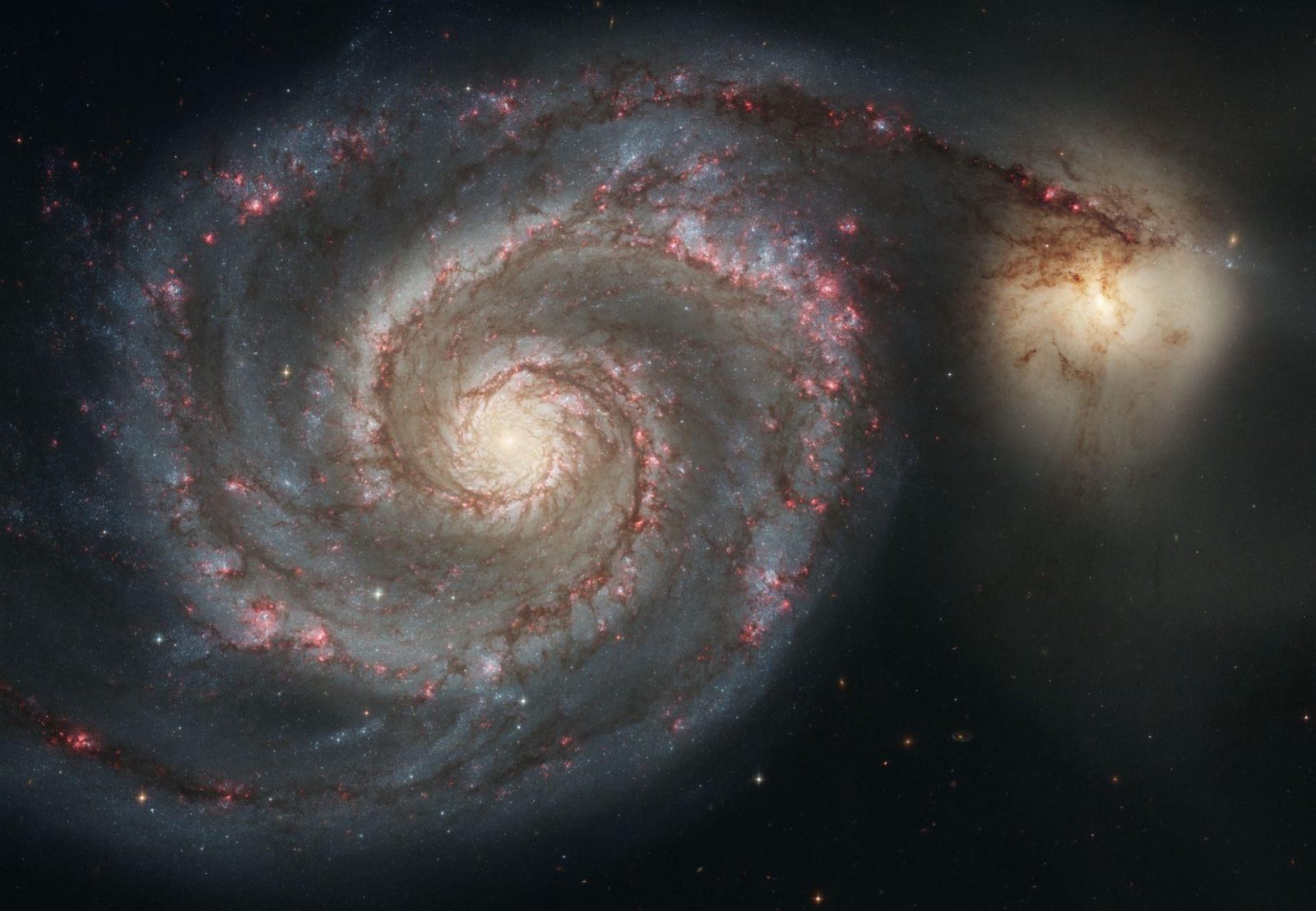


NASA's Hubble Space Telescope captures a stunning, high-resolution image of the spiral galaxy IC 1954, located 45 million light-years away. With the help of other telescopes, this image provides crucial information about the process of star formation and the evolution of galaxies. The data from different wavelengths reveals the active regions where stars are being born and provides a foundation for ongoing research into galactic evolution and the forces shaping the universe.
Hubble Captures Stunning Image of Spiral Galaxy IC 1954
NASA's Hubble Space Telescope has unveiled a breathtaking, high-resolution image of the spiral galaxy IC 1954, situated approximately 45 million light-years away. This image offers valuable insights into star formation and galactic evolution.
Background on Spiral Galaxies
Spiral galaxies, like IC 1954, are characterized by their distinct spiral arms. These arms are regions of intense star formation where gas and dust condense to form new stars. The rotation of the galaxy causes the arms to sweep through space, creating the characteristic spiral pattern.
Star Formation and Galactic Evolution
IC 1954's image allows astronomers to study the process of star formation within the galaxy. The data from the Hubble Space Telescope and other telescopes reveals regions where stars are actively being born. This information helps scientists understand how galaxies evolve and the forces that shape their structure.
Composition and Findings
The image reveals a wealth of detail about IC 1954's composition and structure. The spiral arms are filled with bright, young stars and star-forming regions. The center of the galaxy contains a bright nucleus, suggesting the presence of a supermassive black hole.
Ongoing Research
The data gathered from IC 1954 will serve as a foundation for ongoing research into galactic evolution. Scientists will use this information to investigate the factors that influence star formation, the distribution of matter within galaxies, and the forces that drive their evolution.
Top 5 FAQs about Hubble and NASA's Cosmic Research
1. What is the Hubble Space Telescope?
The Hubble Space Telescope is an optical and ultraviolet space telescope launched into orbit in 1990. It has revolutionized our understanding of the universe, providing stunning images and invaluable data about distant galaxies, stars, and other celestial objects.
2. What is the significance of IC 1954's image?
IC 1954's image provides a detailed snapshot of a nearby spiral galaxy, revealing insights into star formation, galactic structure, and the evolution of the universe.
3. What other tools are being used to study IC 1954?
In addition to the Hubble Space Telescope, other telescopes such as the Spitzer Space Telescope and the Atacama Large Millimeter/submillimeter Array (ALMA) are being used to collect data about IC 1954 at different wavelengths.
4. What are the ongoing challenges in studying galaxies like IC 1954?
Studying distant galaxies poses several challenges, including their immense distances, the presence of dust and gas that obscures our view, and the limitations of our telescopes. However, scientists continue to develop new techniques and instruments to overcome these challenges.
5. What future discoveries can we expect from Hubble and NASA's cosmic research?
As Hubble and other telescopes continue their observations, we can expect to uncover more secrets of the universe. These discoveries may shed light on the birth and evolution of stars, the formation of galaxies, the nature of black holes, and the ultimate fate of our cosmic neighborhood.

Prime Minister Narendra Modi launched a groundbreaking research, development and innovation scheme that will provide a boost to the flourishing ecosystem of innovation in India. In his address at the Emerging Science, Technology and Innovation Conclave, PM Modi highlighted the crucial role of science and technology in driving transformation and emphasized on India's significant progress in the field. He also acknowledged the remarkable achievement of India's women's cricket team and expressed confidence that their success would inspire the country's youth. Attendees included renowned scientists, innovators, and distinguished guests from both India and abroad.

Indian Prime Minister Narendra Modi inaugurated the Emerging Science and Technology Innovation Conclave (ESTIC) 2025 and launched the Rs 1 lakh crore Research Development and Innovation (RDI) Scheme Fund. The scheme aims to strengthen the private sector-driven research and innovation ecosystem in the country and has a total outlay of Rs 1 lakh crore over 6 years. ESTIC 2025, gathering over 3,000 participants, focuses on 11 critical thematic areas including Artificial Intelligence, Quantum Science and Technology, and Space Technologies, providing opportunities for collaboration and reinforcing India’s science and technology ecosystem.

In this edition of Health360, a renewed debate over the alleged link between vaccines and autism is sparked by tech mogul Sridhar Vembu's endorsement of a questionable study. Despite reassurances from the medical community backed by data from the WHO, doubts continue to persist, leading to potential harm to public health. The program also delves into the alarming rise in back pain cases in India and explores new treatments.

In an effort to fight the ongoing air pollution crisis, Delhi conducted its first-ever official cloud seeding operation led by IIT Kanpur. The operation involved a small aircraft dispersing specially designed chemical flares into the atmosphere to create rain. While experts say rainfall could occur within 15 minutes to 4 hours, the actual timeframe depends on various factors such as wind direction and moisture content. If successful, the government plans to continue the operation in the coming days.

In the quest for stronger, luscious hair, we often overlook the importance of nurturing the roots. Fortunately, Ayurveda has long stressed the significance of this practice, which has now been backed by modern science. Studies have shown that herbs like Bhringraj and Amla can activate hair follicles, promoting new growth and delaying greying. Fenugreek, Neem, Hibiscus, and Ashwagandha are also found to be beneficial in strengthening and nourishing the scalp, resulting in thicker and healthier hair.

A college student shares her personal journey of becoming a vegetarian, despite facing challenges and health concerns. She then delves into an ethics class she took, where the concept of marginal cases were discussed. Following an article by philosophy professor Alastair Norcross, she concludes that even though individual action may seem insignificant, refusing to consume factory-farmed meat holds moral significance due to the potential to prevent immense suffering for animals.

On October 24, the global community commemorates World Polio Day to honor the legacy of Dr. Jonas Salk and the efforts of countless individuals and organizations in the fight against polio. This highly contagious and potentially deadly disease, once a widespread epidemic, is now largely preventable thanks to the development of a life-saving vaccine. India's successful eradication of polio serves as a testament to the importance of strong vaccination programs and collaborations in public health initiatives.

As winter arrives in India, so does the hazardous air pollution. Delhi NCR's AQI has already crossed the 400 mark, making it crucial to invest in air purifiers, especially after Diwali. Dyson, Qubo, HomePure, and Philips have launched high-quality air purifiers with advanced features to tackle different types of pollutants and create cleaner indoor air. With prices ranging from Rs 5,000 to Rs 1 lakh, these purifiers are a practical and timely purchase for a healthier living.

In a recent family vlog, Indian celebrity couple Shoaib Ibrahim and Dipika Kakar shared their "natural" hair care routine for their son, using a homemade mask made with rice flour, flax seeds, and coconut oil. However, experts warn that what works for adults may not be suitable for babies, whose sensitive skin and scalp could react to the ingredients. While the ingredients may improve hair texture, they do not necessarily promote hair growth. Instead, a healthy diet and good scalp care are more important in maintaining healthy hair.

A recent consumer study has found multiple brands of soft contact lenses in the U.S. to contain "forever chemicals" that can be harmful to both the body and the environment. The study, conducted by the nonprofit organization Environmental Health Sciences, tested 18 varieties of popular contact lenses and found all of them to contain markers for PFAS. Brands such as Acuvue, Alcon, and CooperVision were among the list of affected products. This news serves as a cautionary lesson on the potential risks of overusing contact lenses.